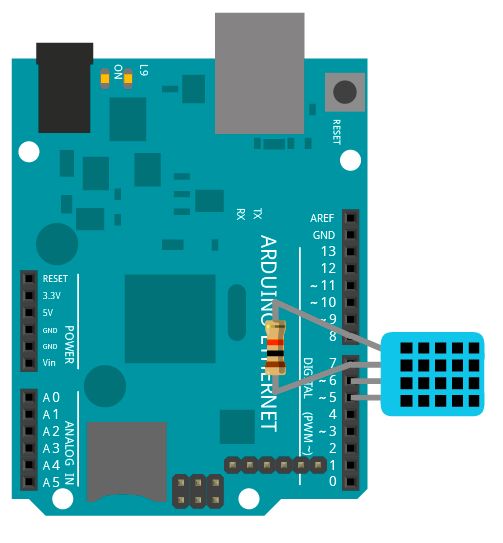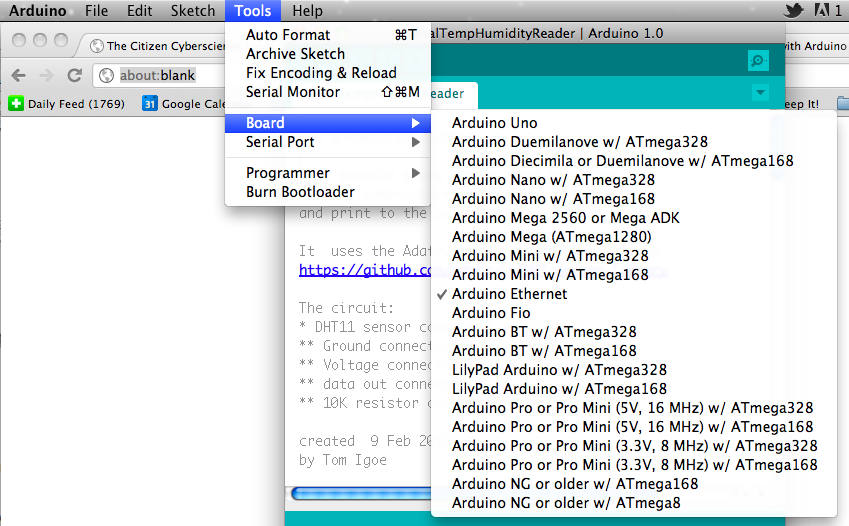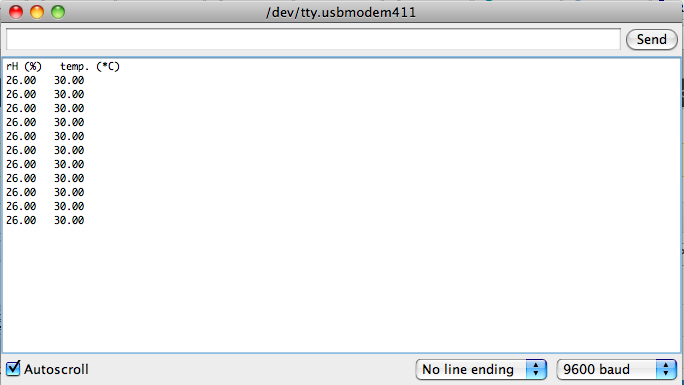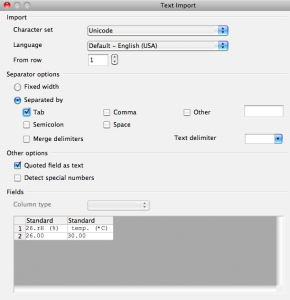There are several ways to save data from a sensor attached to an Arduino. If you’re connected to a personal computer, you can simply send the data from the Arduino to the personal computer serially, and save it to a file. If you’ve got an SD card attached to the microcontroller, you can save the data to the card. Or, if you have access to the internet and a device that can connect to a server, you can save the data to a server. In the tutorial below, you’ll read a DHT11 temperature and humidity sensor and log data in three ways:
- Serial transmission to a personal computer, and serial capture to a file.
- Saving data to an SD card mounted on the Arduino
- HTTP upload to xively.com (formerly pachube.com) via an Ethernet shield or Ethernet Arduino.
Hardware you need:
- personal computer
- Ethernet Arduino and USB-to-serial connector, or Arduino Uno and Ethernet shield (or equivalents)
- SD Micro card
- DHT11 temperature and humidity sensor
- 10-kilohm resistor
Software you need:
Concepts you should know:
- Basic understanding of Arduino code
- Basic electrical concepts
- Serial communication concepts
- How to install libraries in Arduino
- HTTP request concepts
For more on the DHT sensors, see Adafruit’s tutorial.
To get started, install the Arduino IDE and download the DHT library. Unzip the library and change the directory name to DHT, then copy it to the libraries/ directory of your Arduino sketch directory. If this is your first time using Arduino, the default location is in your user directory, called Arduino/ . You might have to create the libraries directory inside the sketch directory. Then download the example sketches from my gitHub repository, unzip them and save them to your sketch directory as well. Then start the Arduino IDE.
Connecting the sensor
Connect the DHT11 sensor to the Arduino as follows:
- Vcc (pin 1) – Digital pin 8
- Output (pin 2) – Digital pin 7
- Ground (pin 4) – Digital pin 5
Since the DHT11 sensor uses very little current, you can use the output pins of the microcontoller to power the sensor, using pins 5 and 8. Then attach the output pin of the sensor to pin 7. The output pin will also need a pullup resistor so that it goes high when no data is transmitted. To do this, connect the 10-kilohm resistor from pin 8 to pin 7, or to the +5V pin.

Serial Data Capture to a Graph
The simplest way to get data off the sensor is to print the results out serially and capture them directly on your computer. To make this happen, you’ll need your Arduino attached via a USB-to-serial connection. The sketch SerialTempHumidityReader uses the Adafruit DHT library to read the sensor and sends the results back to the computer serially. Download it and copy it into a new window in the Arduino IDE.
To upload the sketch to your board, connect the board to the computer via USB-to-serial, and look for the board type in the Tools > Board menu. Assuming you’re using an Arduino Ethernet, choose that:

To find your serial port, check the Tools >Serial Port menu with the USB-to-serial adapter NOT connected. Then plug the adapter into your computer again and check the menu again. The new port that shows up is your USB-to-serial adapter’s port.
Once you’ve selected the board type and the port, upload the sketch by clicking the upload button in the toolbar, or ctrl-U:

When you’ve got the sketch loaded, open the serial monitor by clicking the Serial Monitor button on the right hand side of the toolbar.

You should see readings like this:

The sketch is outputting tab-separated data, and prints out column headers at the beginning.
When you’ve got several readings, click in the serial monitor window, select all (ctrl-A), and copy (ctrl-C). Then open a blank spreadsheet in OpenOffice and paste the results into the sheet. When the Text Import dialog comes up, make sure you click Separated by Tab in the Separator options:

Select the two columns of numbers, and click the graph icon. In the Graph dialog box, choose Line type, the Lines Only option, then click Finish. Your graph will be inserted in your spreadsheet. Voila, graphing made simple!
Serial Data Capture to a File
If you have a serial terminal program like CoolTerm on your computer, you can also capture to a file. To do so, open CoolTerm, and choose your serial port in the Options menu. Click the Connect icon, then from the Connection Menu, choose Capture to TextFile… and Start. Give your file a name and save.
Note: if you want the file to start from the beginning of your sketch, hold down the reset until you’ve started capture.
To stop capture, choose Connect > Capture to TextFile… > Stop. Then you can use your file in any application you want. Change the file extension to .csv and you can open it in a spreadsheet and graph as above.
Saving Data to an SD Card
Sometimes you want to save data when you’re not connected to a personal computer. Attaching an SD card to an Arduino is fairly straightforward. There are several different shields that have SD cards on board, and the Arduino Ethernet has an SD card right on the main board. The SD card library makes it simple to save files to your SD card.
Format a microSD card as FAT16 or FAT32 on your personal computer, and load it onto your Arduino. Then upload the SDCardDataLogger sketch. This sketch reads the sensor using the Adafuit DHT library, and if there is an SD card present and initialized, it saves the results to a file called “DATALOG.CSV”. Transfer this file to your computer and use it as you wish. You can open it in a spreadsheet and graph it as you did above, or anything else you wish.
Posting data to Xively.com
If your Arduino is connected to the internet via Ethernet, you can connect to pachube.com and program it to post data there. Then you can use Pachube’s data storage and graphing tools to save and visualize your data.
Set up a xively.com account. Click Create a Feed. Give it a name, add any descriptive tags you want, and add a location if you wish. Add two datastreams called rH (relative humidity) and temp (temperature) as follows:

Write down the feed number and fill it into the feed variable in the sketch (PachubeDataLogger). You’ll also need your API key, which is a long string that identifies you to pachube.com. Click My Keys from the pachube menu to get your key. Copy it into the apiKey variable in the sketch below.
Upload this sketch to your Arduino, and connect the board to the net via Ethernet. Open the serial monitor. When the sketch starts, it will look for an IP address using DHCP. Then every ten seconds, it will read the sensor and try to upload to Pachube. A successful upload will print out something like this:
192.168.2.6
rH,26.00
temp,30.00
connecting...
data uploaded
HTTP/1.1 200 OK
Date: Sat, 16 Feb 2012 10:03:14 GMT
Content-Type: text/plain; charset=utf-8
Connection: close
X-Pachube-Logging-Key: logging.G5DkQtnxEdwyKbk0KSKI
X-PachubeRequestId: 0b4efe30282b715276cf1f849f7123ed3eaba234
Cache-Control: max-age=0
Content-Length: 1
Age: 0
Vary: Accept-Encoding
When you look at your feed, you’ll see a graph of your temperature and humidity.
Now you’ve got several methods to log data from an Arduino. You can change the sensor to any sensor you wish, and revise the sketches shown here to read that sensor instead of the DHT11. Enjoy!
Update
I’ve added code to the repository for this tutorial that shows how to use the Pachube code with a BMP085 barometric pressure sensor. Thanks to Adafruit for the excellent library for this sensor. I’ve also added an example showing how to use the BMP085 with the SD card, and with a Realtime Clock. Again, Adafruit’s library for the RTC makes this easy.
Update 2
Pachube became xively.com, and then they became part of the Google IoT Cloud platform, so I can’t vouch for the validity of any of the pachube examples on this page now. They may work, if xively/Google didn’t change the API.






